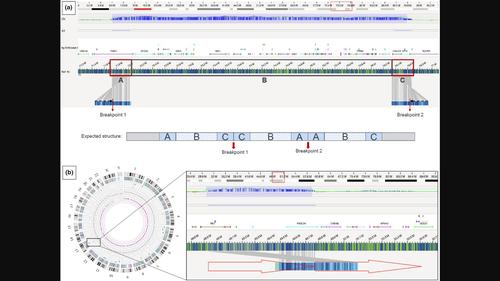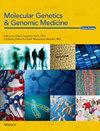光学基因组图谱在快速鉴定 RB1 复制和 15q23q24.2 三重复制方面的临床价值,以提供更适当的产前遗传咨询
IF 1.5
4区 医学
Q4 GENETICS & HEREDITY
引用次数: 0
摘要
背景尽管产前基因诊断取得了最新进展,但医学遗传学家在解释拷贝数变异重复的临床结果和确定某些染色体重排的形成机制方面仍面临相当大的困难。方法在此,我们报告了在产前诊断中使用光学基因组测绘(OGM)的情况。我们利用详细的断点图谱确定了两个无血缘关系胎儿染色体畸变的三倍段和重复段的相对方向:一个是新发的 15q23q24.2 三倍段,另一个是父系遗传的 13q14.2 重复段,该重复段与 RB1 基因部分重叠。结果OGM 使我们能够提出三倍段的合理机制,并证实 RB1 重复段是直接定向和串联的。结论随着诊断率的提高,OGM 可以迅速突出基因型与表型的相关性,改善遗传咨询,并对产前管理产生重大影响。本文章由计算机程序翻译,如有差异,请以英文原文为准。

The clinical value of optical genome mapping in the rapid characterization of RB1 duplication and 15q23q24.2 triplication, for more appropriate prenatal genetic counselling
BackgroundDespite recent advances in prenatal genetic diagnosis, medical geneticists still face considerable difficulty in interpreting the clinical outcome of copy‐number‐variant duplications and defining the mechanisms underlying the formation of certain chromosomal rearrangements.Optical genome mapping (OGM) is an emerging cytogenomic tool with proved ability to identify the full spectrum of cytogenetic aberrations.MethodsHere, we report on the use of OGM in a prenatal diagnosis setting. Detailed breakpoint mapping was used to determine the relative orientations of triplicated and duplicated segments in two unrelated foetuses harbouring chromosomal aberrations: a de novo 15q23q24.2 triplication and a paternally inherited 13q14.2 duplication that overlapped partially with the RB1 gene.ResultsOGM enabled us to suggest a plausible mechanism for the triplication and confirmed that the RB1 duplication was direct oriented and in tandem . This enabled us to predict the pathogenic consequences, refine the prognosis and adapt the follow‐up and familial screening appropriately.ConclusionAlong with an increase in diagnostic rates, OGM can rapidly highlight genotype–phenotype correlations, improve genetic counselling and significantly influence prenatal management.
求助全文
通过发布文献求助,成功后即可免费获取论文全文。
去求助
来源期刊

Molecular Genetics & Genomic Medicine
Biochemistry, Genetics and Molecular Biology-Genetics
CiteScore
4.20
自引率
0.00%
发文量
241
审稿时长
14 weeks
期刊介绍:
Molecular Genetics & Genomic Medicine is a peer-reviewed journal for rapid dissemination of quality research related to the dynamically developing areas of human, molecular and medical genetics. The journal publishes original research articles covering findings in phenotypic, molecular, biological, and genomic aspects of genomic variation, inherited disorders and birth defects. The broad publishing spectrum of Molecular Genetics & Genomic Medicine includes rare and common disorders from diagnosis to treatment. Examples of appropriate articles include reports of novel disease genes, functional studies of genetic variants, in-depth genotype-phenotype studies, genomic analysis of inherited disorders, molecular diagnostic methods, medical bioinformatics, ethical, legal, and social implications (ELSI), and approaches to clinical diagnosis. Molecular Genetics & Genomic Medicine provides a scientific home for next generation sequencing studies of rare and common disorders, which will make research in this fascinating area easily and rapidly accessible to the scientific community. This will serve as the basis for translating next generation sequencing studies into individualized diagnostics and therapeutics, for day-to-day medical care.
Molecular Genetics & Genomic Medicine publishes original research articles, reviews, and research methods papers, along with invited editorials and commentaries. Original research papers must report well-conducted research with conclusions supported by the data presented.
 求助内容:
求助内容: 应助结果提醒方式:
应助结果提醒方式:


